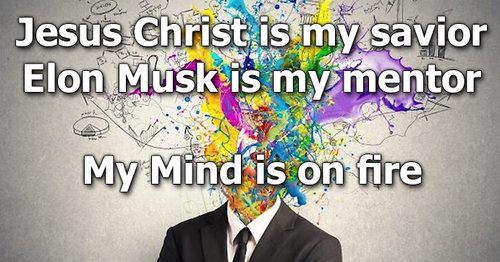6 criteria to recognize dubious business models
.jpg)
They show pictures of dream beaches, dream houses and dream cars. For those you can catch in your nets, a euphoric time follows – everything seems possible. At some point, the crash comes – and in addition to money and time, many lose their friends, families and acquaintances in the process. We are not talking about cults here. We are talking about dubious business models. These dubious business models can often be recognized by their sales structures.
It is very likely that you will also be recruited as a salesperson for such a company at some point. If you are not a salesman type – please keep your hands off all these systems anyway. These systems are all about hardcore sales (and here the distinction between serious and unserious doesn't even matter – if you don't want to do sales, all these systems are not for you).
Of course, nobody admits to working in such a dubious business model. I even believe that many of them do not even understand what they are doing. What makes it difficult is that there are also serious companies that work with these systems. We are talking about systems that often call themselves as follows:
– MLM systems (MLM = Multi Level Marketing).
– Network marketing or network marketing
– Referral marketing
– Structural marketing
As I said, there are both serious and dubious companies that use these forms of distribution. In this article I show different criteria, on the basis of which everyone can subject the enterprises to an evaluation. I write this in the hope that I can save one or the other person from the dubious systems. I cannot and will not provide a list of what I consider to be dubious companies – firstly, that would be quite an effort, and secondly, it would increase the risk of legal disputes with me, which I have neither the desire nor the time for. If you ask me personally, you might get an estimation – but most of the things you should be able to estimate yourself with the criteria mentioned below.
Before that, a little detour to the legality of such systems. It is important to note: Legal is not the same as serious.
The law says that it must not be the goal to bring as many people as possible into the system. If a profit can only be made by recruiting more and more people, then the system is not legal, because it is then a snowball or pyramid scheme. Ponzi schemes are dangerous because they require infinite growth in a finite world to be successful in the long run. All those who enter after a certain level are the losers (the last one bites the dog). Statistically, 10% of the participants manage to earn more than you pay in. 10% get out approximately what they paid in. And 80% lose money. This means:
1.there is a very high probability that you will lose money.
2.the moral question is: can you justify that 80%-100% of the people recruited by you or under you will lose money (time, friends, family) with it? Every participant of such a system carries this responsibility as a co-debtor.
The problem in recognizing such systems is that many of the typical mechanisms can be disguised. I will go into this in more detail in the criteria – close scrutiny is the key to recognition here.
There is one argumentation that I find remarkable in this context: The law contains the word "consumer". Someone who registers a trade is no longer a consumer, but a trader. This undermines the law – because a trader has a higher level of personal responsibility than a consumer and is free to choose to be ripped off.
Criteria for recognizing dubious systems
These criteria are all clues that should be taken into account during an audit. As soon as something seems strange to you, leave it alone. Unfortunately, these criteria are sometimes not clear enough to come to a clear conclusion. It is more about tendencies. Depending on the person, a less strong tendency will be enough to not fall for a system. Some will only distance themselves from stronger tendencies. For me, it's about raising awareness and giving the right questions to ask. It is always important to ask a lot of questions. Do a lot of research. A mnemonic:
The closer you are to the person you are addressing, the more research you should do. If you don't know the person at all, put at least 1 day of research into the topic before you agree or even sign anything. Multiply this time the closer you are to the person 🙂
1.Spend money to get started
If the new participant has to pay money (often over a thousand euros) to join, this is a strong criterion for a dubious system. Creative people have come up with various tactics to justify your investment with a seemingly worthwhile or seemingly logical return:
– Buy product – buy a product here to get started. Travel vouchers, watches, nutritional supplements and many other high-value product lines (luxury items) are popular. Research exactly what the products are worth here. A branded watch is worthless if no one knows the brand. Run with it to a watch salesman and try to sell him the watch. The question is not whether the movement is as high quality as that of, say, a Rolex. The question is whether someone is willing to pay a lot of money for an unknown brand.
– disguised product purchase – in this system there is a theoretical possibility to be in it without prior product purchase, but then at a worse level with much lower earning potential. So you can be there without entry money, but your commissions will be even lower as a result.
In practice, they will then try to convince you (and all other newbies) that it doesn't make sense to miss out on future profits. So in the argumentation there is the theoretical possibility to join without entry fee, but in practice most of them pay their entry fee.
So here, pressure is built up on you via the argumentation of lower commissions and that it would be intelligent to join with a payment.
– Previous purchase of goods / product range – here the product range must be purchased with your own money. In the perfume sector, you often have to pay for entire perfume boxes with your own money.
– Training / Seminars / Training – here you have to pay for trainings you have to attend before you can join the system.
– License fees – self-explanatory?
In order to finance the entry fee, the distributors sometimes arrange loans, suggest to sell something or even build up pressure until you ask your family and friends for the money. By the unseriöse promise that you swim anyway soon in the money, believe the credits fast to repay to be able. It becomes still worse then (and these cases exist) if one pays then still the entrance fees for the persons recruited by it.
If you should be asked to pay in advance for the entry into a distribution system, then please be very careful.
2.Primary goal: Recruitment of new persons
This is stated in the law quoted above, that it must not be solely or primarily about introducing more participants to the system. Again, the problem is that this is obscured in many current systems. There are, as already written above, any products that serve as a pretext. Ask how many products are sold in the system per person on average (for example per month). You will get either no answer from dubious systems (we don't know) or even a lie. Probably the number of sold products is equal to the number of newly recruited distributors or at least not much higher. And thus newly recruited participants finance the whole system – which is unfair from the wording of the law. A serious company (which wants to sell products) promotes good distributors with high sales rates, and not a large structure without sales rates.
3.The products
Often the products are only mentioned in passing, while being praised to the skies. The best trip (with many hidden pitfalls), the best watch (whose brand has never been heard of outside the system) and so on. Upon closer inspection and research, you find that much of it is, to put it positively, "blatantly exaggerated marketing," to put it negatively, "lies."
A good question to ask yourself is: would I buy the product even if there was no promise of earnings behind it? If the answer is no, then don't buy!
The price question should also be clarified: Is the product overpriced? (e.g. cleaning agent: This is a concentrate, if you dilute it, it lasts 10 times longer and is only 4 times more expensive than the one from the supermarket). A serious system has about market prices. An unseriöses tries here to get more money out and overprices the products (extremely high margin). To evaluate the products according to their real value is not easy – ask enstprechende industry specialists from your circle of acquaintances. You can also ask in a specialty store, call a company or look in internet forums.
4.Complicated compensation systems
In the system is often worked with any complicated compensation systems (binary plan, matrix plan, and many others). There is a simple rule: the more complicated, the less reliable. Do not participate in any system that you do not fully understand within 20 minutes.
5.Dream promise
Now a salesman sits with you and tries to recruit you. Pay close attention to what the salesperson is talking about.
– Is it about the products? Why were they brought to market? What are the target groups?
– Or does he start with dream promises? "You can get rich this fast". Pictures of dream beaches, dream cars and dream houses.
If the focus is on dream promises, then be careful. This sounds very much like a dubious business model.
A reputable company introduces the products to such people who are already convinced of one or more of the company's products. Then, based on actual experience and without exaggeration, a reputable company presents the earning potential (what did the entrants of the last 6 months earn on average last month?).
A unserious company presents dreams and pretends they are within reach. The dubious company does not go into detail about the products and asks which friends and acquaintances should be approached about this great earning opportunity.
6.Dubious business addresses
You can research international business addresses relatively easily today – we found out once with a system that all official addresses of the company run on mailbox providers. You can always recognize this by the fact that it is a business center or two hundred other companies operate at the same address. And since you are already researching, look for the names of the CEOs, former companies of those involved, pending lawsuits and bans in other countries, criticism of the respective system and so on. Be aware that the systems always have an explanation for everything, of course. The most horrible and common explanation for critics: "He used to be with us, he didn't make it, now he's pissed and trying to disrupt our system." Do a lot of research and also talk to dropouts!
These were six characteristics that already bring you very far in the evaluation of a system. You can define more for yourself. There are also a bunch of other possible questions.
– Has the company been on the market for at least 10 years?
– Am I advised to start with family and friends?
– Am I allowed to have one-on-one conversations with participants who have been with the company for a while? Are they as rich as promised? Do you have good excuses for not being yet?
– Do I get all my questions answered, even the difficult ones?
– Is there a proper training concept for the products to be sold afterwards?
– How is the "last one to bite the dog" problem explained in the system? (Note: The number of people on the planet is finite. Calculate how many stages are possible in the binary plan, for example, before all the people on Earth are participants in the system. I was surprised!)
– If you work for yourself, you need a trade. Have you been educated about this? Is there any help with the registration? Are there other legal obligations? (Taxes!)
– What about product liability?
– Is it advertised that the system is so "new" and "innovative"? In most cases it is not!
– Calculate everything exactly – how high are the commissions? (Less than 10%? That is bad! What are the current commission levels of comparable products?) How many products do you need to sell to reach your goals? Calculate everything to the cent. Also who earns how much (upwards in the structure, manufacturer, and so on).
– Look at the products very closely – with travel vouchers there are often blatant restrictions, co-payments and so on. Also read travel reviews with the vouchers if you can find any. If you can't find any, why is that? And if someone praises too much – is it in the system?
So, I hope to have given you some good clues for evaluation. One question I keep hearing is, "Why do so many people get into this kind of system?" This has nothing (!) to do with stupidity. But if someone credibly promises you quick riches and can somehow present that as realistic, then people quickly fall for it. Mostly, these are people who want to achieve something in life, i.e. highly motivated people.
Finally, it remains to be said that a Ponzi scheme is something different from the Ponzi schemes described here. The terms are often used synonymously, but this is not correct. And again:
If it seems strange to you , then leave it alone








 Ukrainians waiting on border
Ukrainians waiting on border
.jpg)


.jpg)
.jpg)



.jpg)